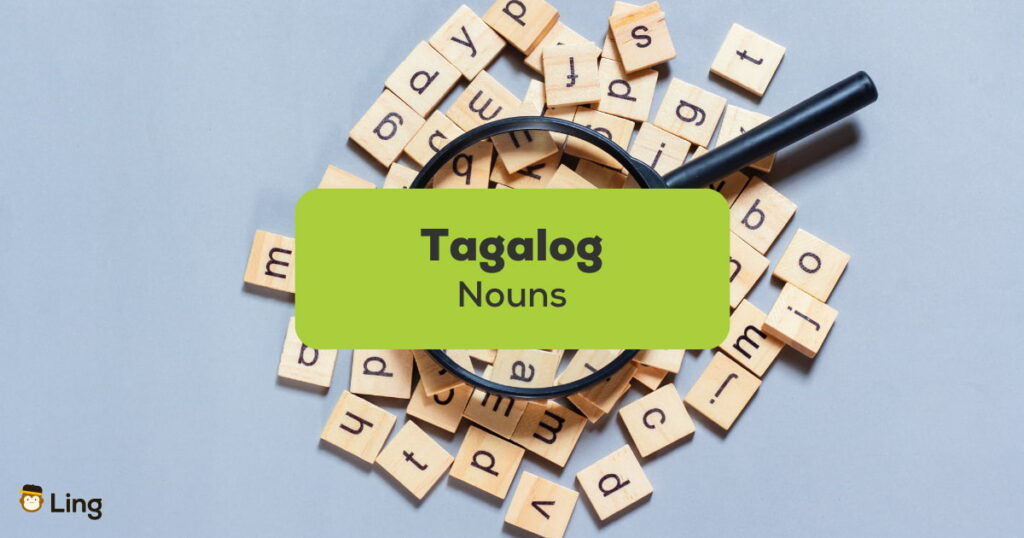Are you here to learn the basics of speaking Tagalog? Then you should probably start like how Filipinos start – learning Tagalog nouns.
When Filipino students begin learning about grammar, one of the first Tagalog lessons that they will learn is nouns. It is the simplest part of speech that every Filipino student should learn. So today, you’ll be learning Filipino/Tagalog nouns like a native student who is just beginning to learn Filipino grammar. So, widen your Tagalog vocabulary and grammar understanding with these Tagalog nouns.
What Are Nouns In Tagalog?
Nouns in the Filipino or Tagalog language are called pangngalan. But don’t get confused with the word pangalan, meaning “name,“ as they are almost similar with regard to spelling and pronunciation!
Many foreigners and even young locals get confused with these two Tagalog words. The term pangngalan (noun) is composed of two words: the affix pang, which means “used to,” and ngalan, “name.”
When you combine these two terms, it becomes pangngalan. It is a word and part of speech that is used to name a person (tao), thing (bagay), place (lugar), event, or phenomenon (pangyayari).
If you look at the definition of Tagalog nouns, they are used the same as English nouns. The only difference is that the Filipino/Tagalog languages have quite complicated grammatical genders. It means that specific Tagalog nouns are used for a certain gender.
Tagalog nouns and English nouns or other languages have a lot in common. Still, of course, some things are unique in the Filipino/Tagalog language. Those are what we are going to discover in this blog.
Types Of Tagalog Nouns
After learning the Tagalog word for nouns and their definitions, we will learn the two main types of Tagalog nouns: Pangngalang Panatangi (Proper Nouns) and Pangngalang Pambalana (Common Nouns).
It won’t be too hard for you if you’re an English speaker because it works the same. Here, you will learn the different Tagalog nouns and the types, forms, and gender of nouns. You will also learn about plural nouns. So keep reading!
1. Pangngalang Pantangi (Proper Noun)
Pangngalang pantangi or proper nouns are used for a specific person, thing, place, or phenomenon. The Tagalog word for specific is tiyak, which you will often hear when the teacher/tutor discusses Tagalog nouns.
Like in the English language, pangngalang pantangi always starts in big letters (capitalized).
2. Pangngalang Pambalana (Common Noun)
Pangngalang pambalana or common nouns are nouns used to name a person, thing, place, or phenomenon in a general form. The Tagalog term for general is karaniwan.
Pangngalang pambalana is written starting with small letters except if found at the beginning of the sentence.
Below is a table that contains the example of pangngalang pantangi and its counterpart for pangngalang pambalana according to category:
| Noun | Pangngalang Pambalana (Common Nouns) | Pangngalang Pantangi (Proper Nouns) |
|---|---|---|
| Tao (Person/People) | presidente (president) mang-aawit (singer) bayani (hero) artists (actor/actress) atleta (athlete) | Ferdinand Marcos Jr. Regine Velasquez Jose Rizal Jericho Rosales Manny Pacquiao |
| Bagay (Things) | kotse (car) bag (bag) sapatos (shoes) kompyuter/computer (they also use the English word) cellphone (telepono can be used but it also refers to landlines) | Toyota Hermes Nike Acer Iphone |
| Lugar (Place) | restawran (restaurant) fast food chain mall (mall) unibersidad (university) ospital (hospital) Museo (museum) | Kuya J Jollibee Mall of Asia Unibersidad ng Pilipinas St. Luke’s Medical Center National Museum of the Philippines |
| Pangyayari (Event/Phenomenon) | pagdiriwang (ocassion) kapistahan (feast) historikal na pangyayari (historical event) piyesta opisyal (holiday) | Pasko Sinulog Festival Sigaw sa Pugad Lawin Araw ng Kagitingan |
As you can notice, the Tagalog language has many loaned words from foreign languages, mostly Spanish and English. The reason traces back to the Philippines being a colony of Spain and the United States.
It is what makes the Tagalog language easy to understand by foreigners. And also why many Filipinos know how to speak English fluently. English is taught in schools and universities.
If you want to learn the Tagalog language, consider using the Ling app. It’s an effective gamified language learning app available on Google Play and the App Store!

Types Of Tagalog Nouns Based On Concept
Now that you have learned the two basic types of Tagalog nouns, let us go deeper. Tagalog nouns are also classified based on the concepts – tahas, basal, and lansakan.
1. Tahas (Concrete)
Tahas or concrete nouns are those that can be perceived by the five senses. Touch (pandama), sight (paningin), smell (pang-amoy), hearing (pandinig), and taste (panlasa).
It also includes the things that have physical characteristics. Here are some examples of pangngalang tahas:
- (mabangong) bulaklak – fragrant flower
- (masarap) na pagkain – delicious food
- (malambot) na unan – soft pillow
If you can notice, I included Tagalog adjectives (pang-uri) before the nouns (pangngalan) to indicate that the senses can perceive them.
2. Basal (Not Concrete)
On the other hand, Basal refers to nouns that have no physical appearance or those what we call abstract ideas. Basal can be an idea or concept:
- pag-ibig (love)
- kalungkutan (sadness)
- lamig (coldness)
- kalayaan (freedom)
- kahirapan (poverty)
- kapangyarihan (power)
3. Palansak (Collective)
Lansakan refers to the collective nouns. When you see these nouns, you’ll know that they are in the plural form.
- grupo (group)
- hukbo (army)
- komite (committee)
- organisasyon (organization)
Gender Of Tagalog Nouns
In the Filipino language, some nouns have a specific gender. People can’t use these nouns interchangeably. Filipinos often add the letter “a” on the nouns for women and “o” for men on the root word. However, this might not always be the case.
1. Pangngalang Panlalaki And Pambabae (Nouns For Man And Woman)
Aside from the nouns used for women and men, some nouns don’t have gender, and some don’t have a specific gender. Take a look at the words below to understand this more.
| English | Pangngalang Panlalaki | English | Pangngalang Pambabae |
|---|---|---|---|
| father | tatay | mother | nanay |
| young man | binata | young woman | dalaga |
| brother | kuya | sister | ate |
| rooster | tandang | hen | inahin |
| uncle | tiyo/tito | aunt | tiya/tita |
| emperor | emperador | empress | emperatris |
| dressmaker | sastre | dressmaker | modista |
| laundress | labandera | laundryman | labandero |
2. Pangngalang Di-Tiyak (Unspecified)
These nouns do not specify gender. They can be used for any gender. This category includes professional titles and roles, as well as common nouns like ‘friend’ and ‘child.’
| English | Tagalog |
|---|---|
| doctor | doktor |
| dentist | dentista |
| doctor | nars |
| teacher | guro |
| dog | aso |
| friend | kaibigan |
| child | bata |
| classmate | kaklase |
| journalist | mamamahayag |
| relative | kamag-anak |
3. Pangngalang Walang Kasarian (No Gender)
These nouns are gender-neutral and typically refer to inanimate objects or general concepts. They include names of objects, places, or ideas.
| English | Tagalog |
|---|---|
| chair | upuan |
| airplane | eroplano |
| book | libro |
| house | bahay |
| building | gusali |
Forms Of Tagalog Nouns
The forms of Tagalog nouns are kind of complicated for beginners. It requires a deeper understanding of Filipino/Tagalog grammar. If you have a strong grasp of Tagalog grammar, you can easily understand how the words are formed. These are the forms of Tagalog nouns:
1. Payak – These Tagalog nouns are made solely of root words.
- tao (man/person)
- paligid (environment)
- sulat (letter)
- kanta (song)
- tuwa (joy)
2. Maylapi – These are Tagalog nouns made of root words plus affixes. If you can still recall, affixes in English are morphemes attached to a word stem to form a new word. In English, we have prefixes (attached at the beginning of a root word) and suffixes (attached at the end of a root word). In Filipino, we have four affixes or panlapi:
- unlapi (from the word unahan which means “at the beginning”)
- gitlapi (from gitna, which means “at the beginning”)
- hulapi (from hulihan which means “at the end”)
- kabilaan (found both in the beginning and end)
- laguhan (found in the beginning, middle, and end)
Take note that the last two affixes (panlapi) are commonly used in Tagalog verbs, but not so much in Tagalog nouns. Below are examples of Tagalog nouns with panlapi (affixes). The affixes (panalpi are already in bold):
| Salitang-Ugat (Root Words) | Panlapi (Affixes) | Type of Panlapi/Notes |
|---|---|---|
| tao (man/person) | pagkatao (personality) | unlapi |
| paligid (surroundings) | kapaligiran (environment) | kabilaan note that Filipinos tend to change “d” to “r” for the word to be pronounced easily. |
| sulat (letter) | sulatin (literary piece) | hulapi |
| kanta (song) | kantahan (an event that involves people singing) | hulapi |
| tuwa (joy) | katuwaan (katuwaan, gladness) | kabilaan |
| saing (this is literally a just a root word, it will have meaning if panlapi is added) | sinaing (cooked rice) | gitlapi |
3. Inuulit – These are Tagalog nouns made of root words being repeated. The word inuulit literally means “repeated.” There are two types of inuulit:
- Ganap (fully) – The root word is repeated fully.
- Di-ganap (partially) – The woot word is repeated partially.
| Word | Type Of Inuulit |
|---|---|
| sabi-sabi (rumor) | Ganap |
| bali-balita (news spreading) | Di-ganap |
4. Tambalan – These are Tagalog nouns made of two words combined and form different meanings. It came from the word tambal, meaning “pair.” Pangngalang tambalan also has two kinds:
- Ganap (fully) – When the two words are combined and form a different meaning.
- Di-ganap (partially) – When the two words are combined but do not change the meaning of the words.
Here are some examples of pangngalang tambalan:
| Word | Literal Meaning | Contextual Meaning | Uri ng Tambalan |
|---|---|---|---|
| taingang (ear)-kawali (frying pan) | taingang-kawali (ears made of a frying pan) | someone who pretends that he/she doesn’t hear anything | Ganap |
| silid (room)-aralan (study) | silid-aralan (classroom) | classroom | Di-ganap |
These Tagalog nouns are for advanced learners, so if you find this too challenging to understand, do not worry because even the locals learn this in their 5th or 6th grade.
When you have already learned so much about the Tagalog language, these forms will be easy to understand, so don’t be too hard on yourself.
Singular And Plural Form Of Tagalog Nouns
Tagalog nouns are easy to identify if it’s plural or singular. Usually, plural nouns have mga before them. But that’s not always the case. Some nouns are considered plural without the presence of mga.
When you use these words, you don’t have to put mga at the beginning. It is something even locals are usually mistaken about. Check the examples below.
Singular – Plural
- bata (child) – mga bata (children)
- tao (person) – mga tao (people)
But there are also nouns that don’t use mga to become plural, like the following:
- kababaihan (girls; can also be written as mga babae)
- kalalakihan (boys; can also be written as mga lalaki)

Let’s Add Tagalog Adjectives To Tagalog Nouns
Now that you have learned many things about Tagalog nouns, let’s add an adjective to a noun. An adjective in Tagalog is called pang-uri. We will add pang-uri to make these Tagalog nouns useful to you.
- mababait na Pilipino – good Filipinos
- masarap na pagkain – delicious food
- magandang tanawin – beautiful scenery
- mainit na panahon – hot weather
- malakas na ulan – heavy rain
Let’s Add Tagalog Verbs In Tagalog Nouns
After adding an adjective (pang-uri) to the noun, let us now add a Tagalog adjective and form a sentence. Verbs are pretty complicated to understand since the tenses in the Tagalog language are quite extensive and complicated to form, so we will use some easy verbs that might be already familiar to you:
| English | Tagalog | Remarks |
|---|---|---|
| I ate delicious food. | Kumain ako ng masarap na pagkain. | Noun: pagkain Adjective: masarap Verb: kumain |
| I admired the beautiful scenery. | Humanga ako sa magandang tanawin. | Noun: tanawin Adjective: maganda Verb: humanga |
| I felt the hot weather in the Philippines. | Naramdaman ko and mainit na panahon sa Pilipinas. | Noun: panahon Adjective: mainit Verb: naramdaman |
| I got wet because of the heavy rain. | Nabasa ako dahil sa malakas na ulan. | Noun: ulan Adjective: malakas Verb: nabasa |
List Of Tagalog Nouns
| English | Tagalog | Pronunciation |
|---|---|---|
| Animal | Hayop | ha-yop |
| Name | Pangalan | pa-nga-lan |
| Nickname | Palayaw | pa-la-yaw |
| Surname | Apelyido | a-pel-yi-do |
| Address | Tirahan | ti-ra-han |
| Birthday | Kaarawan | ka-a-ra-wan |
| Birthdate | Kapanganakan | ka-pa-nga-na-kan |
| Sex/Gender | Kasarian | ka-sa-ri-an |
| House | Bahay | ba-hay |
| Door | Pinto | pin-to |
| Window | Bintana | bin-ta-na |
| Living room | Sala | sa-la |
| Bedroom | Kwarto | kwar-to |
| Bathroom | Palikuran | pa-li-ku-ran |
| Kitchen | Kusina | ku-si-na |
| Table | Mesa | me-sa |
| Chair | Silya/Upuan | sil-ya/u-pu-an |
| Couch | Sofa | so-fa |
| Picture | Litrato | li-tra-to |
| Air Conditioner | Erkon | er-kon |
| Light | Ilaw | i-law |
| Water | Tubig | tu-big |
| Electricity | Kuryente | ku-ryen-te |
| Television | Telebisyon | te-le-bi-syon |
| Radio | Radyo | ra-dyo |
| Refrigerator | Ref/Pridyider | ref/pri-dyi-der |
| Faucet | Gripo | gri-po |
| School | Eskwelahan | es-kwe-la-han |
| Store | Tindahan | tin-da-han |
| Bus | Bus | boos (like ‘boost’) |
| Train | Tren | tren |
| Child | Anak/Bata | a-nak/ba-ta |
| Friend | Kaibigan | kai-bi-gan |
| Boyfriend/Girlfriend | Kasintahan | ka-sin-ta-han |
| Boyfriend | Nobyo | nob-yo |
| Girlfriend | Nobya | nob-ya |
| Spouse | Asawa | a-sa-wa |
| Policeman | Pulis | pu-lis |
| Firefighter | Bumbero | bum-be-ro |
| Senator | Senador | se-na-dor |
| Politician | Pulitiko | pu-li-ti-ko |
| Maid | Kasambahay | ka-sam-ba-hay |
| Student | Mag-aaral | mag-a-a-ral |
| Farmer | Magsasaka | mag-sa-sa-ka |
| Fisherman | Mangingisda | ma-ngi-ngis-da |
| Carpenter | Karpintero | kar-pin-te-ro |
Tagalog Nouns Aren’t Enough, Learn More!
As you can see, there are many Tagalog words derived from foreign languages like Spanish and English. When you start learning Tagalog, you will know lots of words!
Now, the challenge for you is to understand deeper, the structure, the grammar, and more. If you think that learning Tagalog nouns is enough, you have a long journey to take because this is just the beginning. There are other essential words and parts of speech to learn. In fact, we encourage you to continue learning topics such as Tagalog prepositions, once you master nouns in Tagalog. Thank you for reading!
Updated By: Jefbeck


















